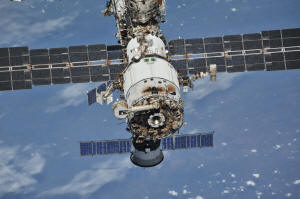What is space debris and how dangerous is it?
 Send a link to a friend
Send a link to a friend
 [November 17, 2021]
By Supantha Mukherjee [November 17, 2021]
By Supantha Mukherjee
STOCKHOLM (Reuters) - Russia's test on
Monday to blow up one of its own satellites in space has drawn criticism
for endangering the crew of the International Space Station and, experts
say, created a debris field that has increased risks to space activities
for years.
WHAT IS SPACE DEBRIS AND WHERE DOES IT COME FROM?
Space debris, or space junk, consists of discarded launch vehicles or
parts of a spacecraft that float around in space hundreds of miles above
the Earth, risking collision with a satellites or a space station.
Debris can also be caused by an explosion in space or when countries
conduct missile tests to destroy their own satellites by missiles. Apart
from Russia, China, the United States and India have shot down
satellites, creating space debris.
As space debris orbits around the earth at tremendous speeds - about
15,700 miles per hour (25,265 kph) in low Earth orbit - it could cause
significant damage to a satellite or a spacecraft in case of a
collision.
"Every satellite that goes into orbit has the potential of becoming
space debris," Professor Hugh Lewis, head of the Astronautics Research
Group at the University of Southampton, said in an interview.

With the launch of more satellites from companies such as Elon Musk's
Starlink and OneWeb satellite constellation, near Earth space will
likely see more space debris.
HOW BIG IS THE DEBRIS?
The U.S. government tracks about 23,000 pieces of debris larger
than a softball orbiting the Earth.
There are half a million pieces of debris larger than 1 centimetre and
100 million pieces of debris about one millimetre or larger.
Debris, particularly near the International Space Station, orbits the
Earth 15 to 16 times a day, increasing the risk of collision.
The European Space Agency (ESA) estimates the total mass of all
space objects in Earth orbit weigh more than 9,600 tonnes.
In a few decades, if the build-up of space debris continues, some
regions of space might become unusable, Holger Krag, head of the ESA's
Space Safety Programme Office, said in an interview.
WHAT WAS THE IMPACT OF THE CURRENT TEST?
The Kosmos 1408 satellite that was destroyed on Monday was launched in
1982 and weighed more than 2,000 kg (4,410 lbs), creating a significant
amount of space debris.
The test generated more than 1,500 pieces of "trackable orbital debris"
and would likely spawn hundreds of thousands of smaller fragments, the
U.S. Space Command said in a statement.
The crew of the space station were directed to take shelter in their
docked spaceship capsules for two hours after the test in case they
needed to leave due to a collision with debris.
[to top of second column]
|

The International Space Station (ISS) photographed by Expedition 56
crew members from a Soyuz spacecraft after undocking, October 4,
2018.NASA/Roscosmos/Handout via REUTERS

"The event happened at an altitude just 80 kilometres
(50 miles) from the space station altitude," Krag said. "So the risk
for the space station will be increased, perhaps even doubled,
compared to what it was before."
WILL SPACE DEBRIS AFFECT SPACE TRAVEL?
While space debris is unlikely to affect space travel, it will lead
to significant problems for spaceflight around Earth.
The risk would be highest for objects orbiting at an altitude of
around 1,000 kilometres (620 miles), which is used for
communications and Earth observation.
"We will still be able to travel to Mars because we will transit
very fast through this problematic region," Krag said.
"But if you want to operate and stay for years in this problematic
region, that might not be possible anymore in a few decades from
now," he said.
CAN SPACE DEBRIS BE REMOVED?
According to NASA , debris in orbits below 600 kilometres will fall
back to Earth within several years, but above 1,000 kilometres it
will continue circling the Earth for a century or more.
"If we want to try and solve the space debris problem, we have to
start to remove that type of object," Lewis said.
Japan's Aerospace Exploration Agency (JAXA) and the European Space
Agency have partnered with start-ups to help with removal of space
debris.
While JAXA has launched a six-month demonstration project with
Astroscale for the world's first debris removal mission, ESA is
working with Swiss start-up ClearSpace for launching a mission
in 2025.
Not only a hazard, space debris increases the cost for satellite
operators.

Satellite operators in the geostationary orbit have estimated
protective and mitigation measures account for about 5-10% of
mission costs and for lower-Earth orbits the cost is higher,
according to an OECD study .
(Reporting by Supantha Mukherjee in Stockholm; Editing by Alex
Richardson)
[© 2021 Thomson Reuters. All rights
reserved.] Copyright 2021 Reuters. All rights reserved. This material may not be published,
broadcast, rewritten or redistributed.
Thompson Reuters is solely responsible for this content. |